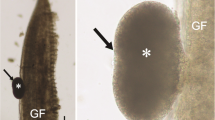Abstract
Atkinsiella dubia, isolated from the mantle of abalone (Haliotis sieboldii), is described and illustrated as a new record from Japan. The fungus was also obtained from the gills of swimming crab (Portunus trituberculatus). Six other species of the genusAtkinsiella have hitherto been reported from various aquatic animals. The fungus is distinguished from the other six species by the morphology of its mycelia and the process of zoospore production. The most distinctive feature is that zoospores in the first motile stage ofA. dubia encyst in zoosporangia, unlike the other species. We therefore proposeHalocrusticida gen. nov. (Lagenidiales, Haliphthoraceae) for the other six species ofAtkinsiella. A key to species of the genusHalocrusticida is provided.
Similar content being viewed by others
Literature cited
Atkins, D. 1954. A marine fungusPlectospira dubia n. sp. (Saprolegniaceae), infecting crustacean eggs and small Crustacea. J. Mar. Biol. Assoc. U. K.33: 721–732.
Bian, B. Z. and Egusa, S. 1980.Atkinsiella hamanaensis sp. nov. isolated from cultivated ova of the mangrove crab,Scylla serrata (Forsskål). J. Fish Dis.3: 373–385.
Fuller, M. S., Fowles, B. E. and McLaughlin, D. J. 1964. Isolation and pure culture study of marine Phycomycetes. Mycologia56: 745–756.
Hatai, K. 1982. On the fungusHaliphthoros milfordensis isolated from temporarily held abalone (Haliotis sieboldii). Fish Pathol.17: 199–204. (In Japanese.)
Hatai, K., Rhoobunjongde, W. and Wada, S. 1992.Haliphthoros milfordensis isolated from gills of juvenile kuruma prawn (Penaeus japonicus) with black gill disease. Trans. Mycol. Soc. Japan33: 185–192.
Kitancharoen, N., Nakamura, K., Wada, S. and Hatai, K. 1994.Atkinsiella awabi sp. nov. isolated from stocked abaloneHaliotis sieboldii. Mycoscience35: 265–270.
Kitancharoen, N. and Hatai, K. 1995. A marine oomyceteAtkinsiella panulirata sp. nov. from philozoma of spiny lobster,Panulirus japonicus. Mycoscience36: 97–104.
Martin, W. W. 1977. The development and possible relationships of a newAtkinsiella parasitic in insect eggs. Amer. J. Bot.64: 760–769.
Nakamura, K. and Hatai, K. 1994.Atkinsiella parasitica sp. nov. isolated from a rotifer,Brachionus plicatilis. Mycoscience35: 383–389.
Nakamura, K. and Hatai, K. 1995. Three species of Lagenidiales isolated from the eggs and zoeae of the marine crabPortunus pelagicus. Mycoscience36: 87–95.
Sparks, A. K. 1985. “Synopsis of invertebrate pathology,” pp. 205–237. Elsevier, Amsterdam.
Sparrow, F. K. 1973. The peculiar marine phycomyceteAtkinsiella dubia from crab eggs. Arch. Mikrobiol.93: 137–144.
Vishniac, H. S. 1958. A new marine Phycomycete. Mycologia50: 66–79.
Author information
Authors and Affiliations
About this article
Cite this article
Nakamura, K., Hatai, K. Atkinsiella dubia and its related species. Mycoscience 36, 431–438 (1995). https://doi.org/10.1007/BF02268628
Accepted:
Issue Date:
DOI: https://doi.org/10.1007/BF02268628




